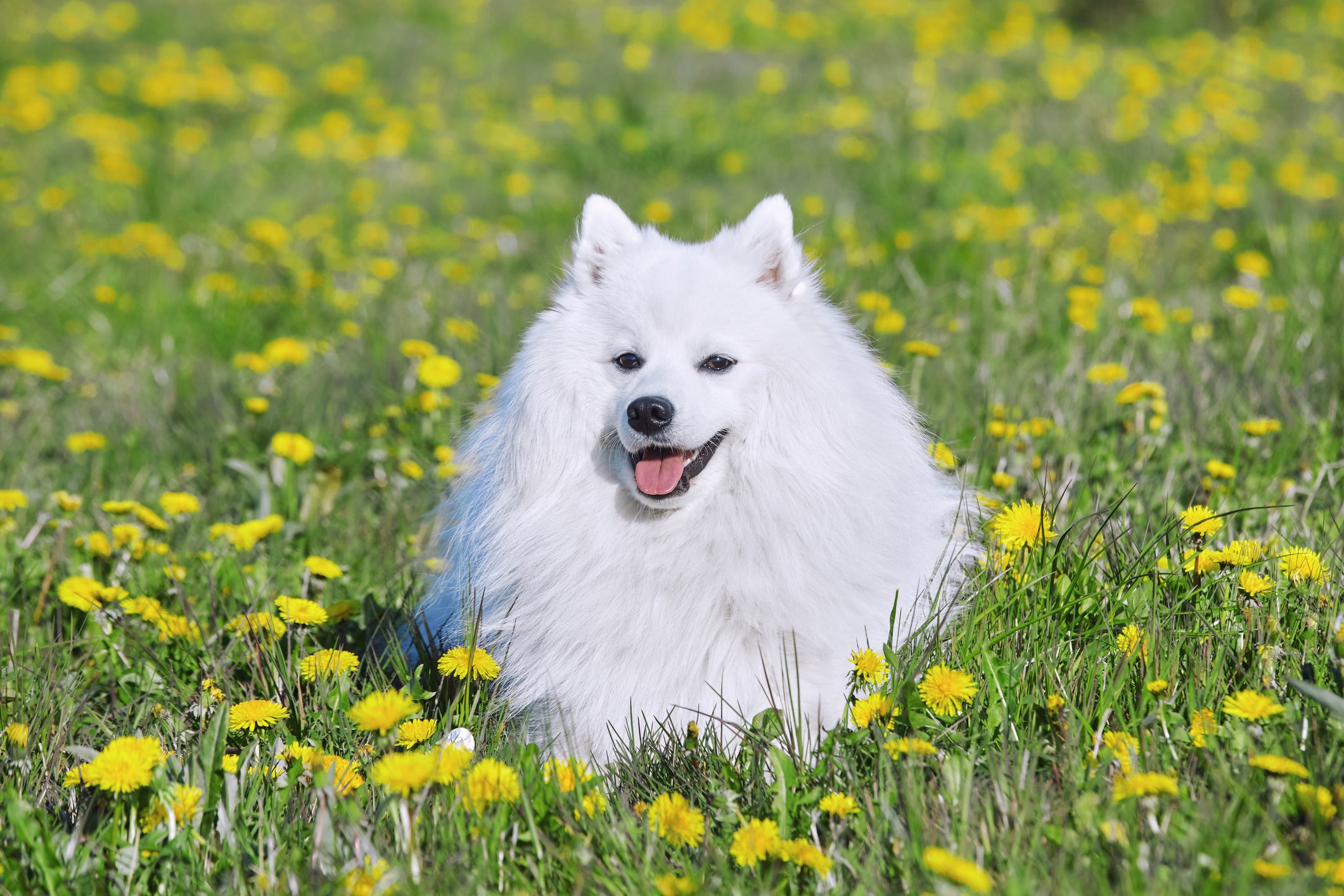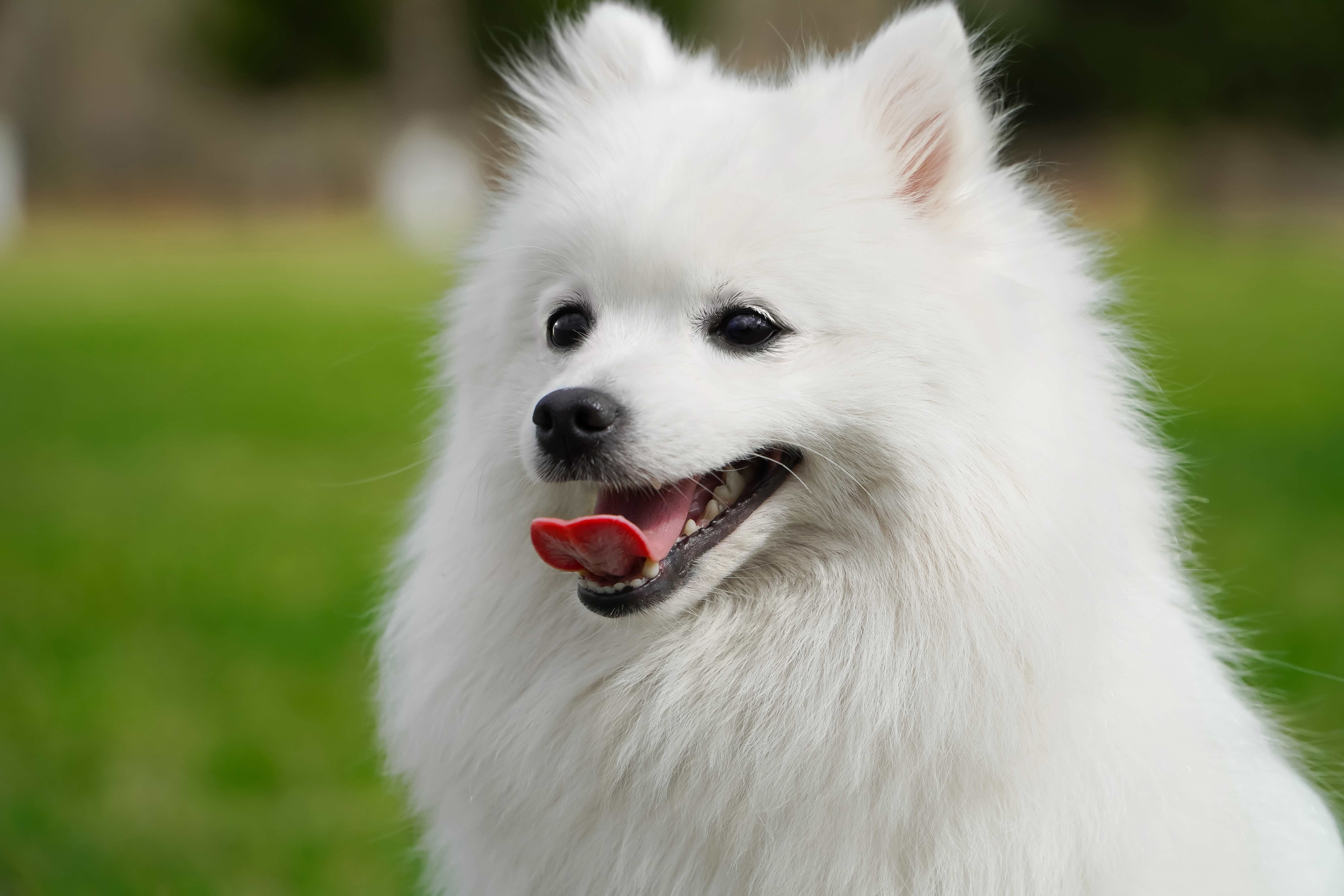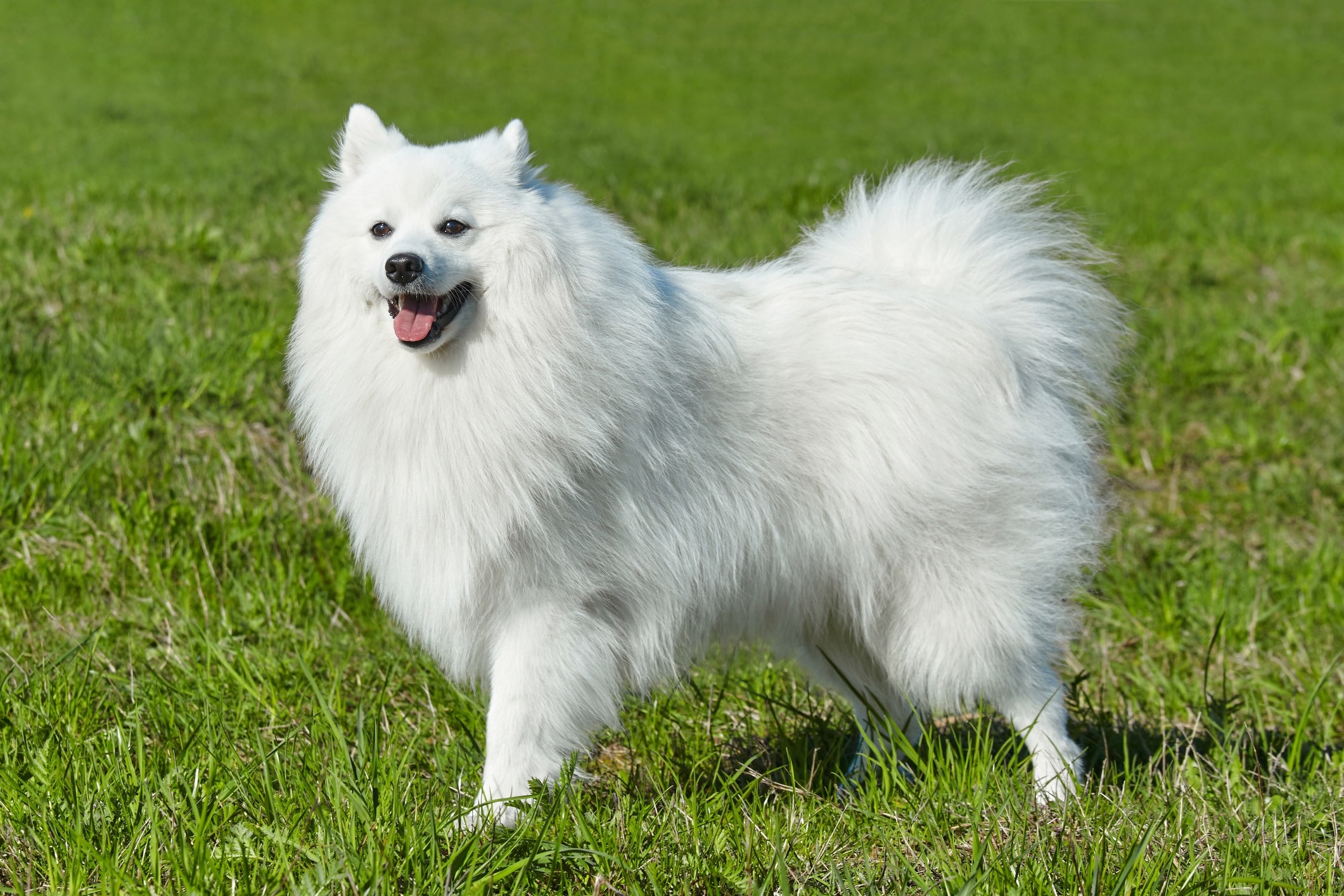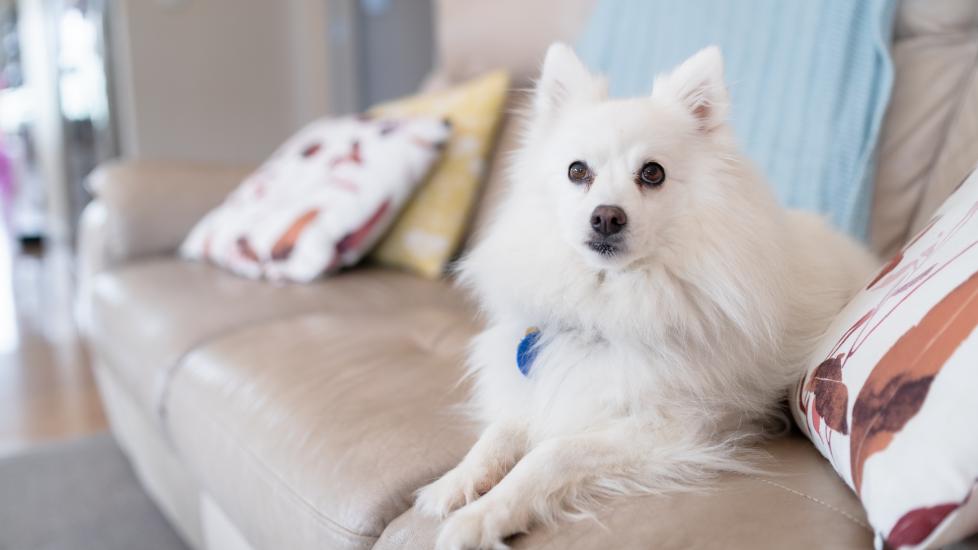Japanese Spitz
nazar_ab/iStock / Getty Images Plus via Getty Images
The Japanese Spitz is known for an elegant white coat, high-set triangular ears, catlike feet, and a tail carried over the back. This dog breed can be traced back to 1920s Japan, according to the Japanese Spitz Club (JSC), though the origins before then are murky. The breed resembles a few other dogs, including the German Spitz, the American Eskimo Dog, and the popular Pomeranian.
Full-grown Japanese Spitz dogs weigh between 10–25 pounds and stand 12–15 inches at the shoulder. They are affectionate, playful, easy to train, small in size, and love to be with their family.
Caring for a Japanese Spitz
The Japanese Spitz is a joyful, low-maintenance breed that makes a great family dog or roadside companion, thanks to their petite stature and laid-back temperament. They are loyal and loving to their family members and, when well-trained and socialized, can be trusted around children, other dogs, and cats.
They have a moderate amount of energy and need about 30–60 minutes of exercise a day, which may consist of a neighborhood walk, playing fetch, or running in the backyard.
Despite their fluff, a Japanese Spitz’s coat requires minimal maintenance most of the year. But when they shed their entire undercoat twice a year, this breed requires daily brushing for a few weeks to minimize fur in the house.
Japanese Spitz Health Issues

The Japanese Spitz is generally a healthy breed that lives 10–14 years on average. However, they can be prone to certain health issues, and pet insurance may be a good investment when you bring home a Japanese Spitz puppy.
Patellar Luxation
Patellar luxation is when a dog’s kneecap moves (luxates) out of place, most often due to the shallow groove in the femur. There are varying degrees of kneecap luxation, with the most severe requiring orthopedic surgery.
Talk to your vet if your dog shows signs of a patellar luxation, which include limping and skipping on occasion during a walk or run.
Muscular Dystrophy
Muscular dystrophy is a rare musculoskeletal disorder that’s inherited in this breed. Japanese Spitz with muscular dystrophy typically show signs starting at 10–12 weeks of age. Symptoms may include difficulty chewing, hypersalivation, exercise intolerance, muscular pain, and incoordination. There is no cure for this condition.
Symptoms slowly progress over several months, and affected Japanese Spitz puppies typically die around 1 year of age. Ensure that your Japanese Spitz breeder has performed genetic testing on their dogs to make sure the genetic mutation responsible for muscular dystrophy isn’t passed down to the puppies.
Factor VII Deficiency
Factor VII deficiency is an inherited bleeding disorder caused by the inability to clot blood when injured. This condition can arise at any age, but usually it’s not noticeable unless a Japanese Spitz is injured or has surgery.
Japanese Spitz with this condition may be asymptomatic or display any of the following symptoms:
-
Excessive bruising
-
Prolonged bleeding when injured
-
Bleeding from the mouth or internally, such as the chest or abdomen
Genetic testing can determine whether your dog has this bleeding disorder. Reputable Japanese Spitz breeders should conduct this test prior to breeding their dogs.
Dental Disease
It’s important to begin brushing your Japanese Spitz puppy’s teeth when they are young because the breed is prone to developing dental calculus and gingivitis at an early age. You can also offer other at-home dental care options, such as VetriScience® Perio Support supplements, OraVet® dental chews, and other products approved by the Veterinary Oral Health Council (VOHC) to minimize tartar buildup.
A professional dental cleaning should be performed annually to keep your dog’s teeth clean and healthy.
What To Feed a Japanese Spitz
A Japanese Spitz should be fed a high-quality, small-breed dog food that meets the nutritional standards set by the Association of American Feed Control Officials (AAFCO). Japanese Spitz, like all dogs, should be fed a diet that matches their life stage (puppy, adult, or senior). Your veterinarian can help you choose the best food for your dog.
How To Feed a Japanese Spitz
Adult Japanese Spitz dogs should be fed twice daily, in the morning and evening. By contrast, Japanese Spitz puppies should eat three times a day to minimize risk for hypoglycemia (low blood glucose).
How Much Should You Feed a Japanese Spitz?
Follow the feeding guidelines on your dog food packaging to learn how much to feed your dog based on their weight. Your vet can give further advice on the proper feeding amount based on your dog’s health, age, and lifestyle.
Once your Japanese Spitz puppy is 1 year old, slowly transition their puppy food to a high-quality, small-breed adult formula. Adult food has fewer calories than puppy food to help prevent unwanted weight gain and obesity.
Nutritional Tips for Japanese Spitz
A healthy Japanese Spitz that’s fed an AAFCO-compliant dog food shouldn’t need anything additional unless your veterinarian recommends supplements for your dog. For example, if your Japanese Spitz has a patellar luxation, they may benefit from a joint supplement and an omega-3 fatty acid supplement (fish oil) to reduce joint inflammation.
Behavior and Training Tips for Japanese Spitz
Japanese Spitz Personality and Temperament

The Japanese Spitz temperament is fun and energetic; this breed loves to entertain their humans by performing tricks and learning skills. They are great with children and other pets as long as they are properly socialized at an early age.
This breed has a moderate amount of energy and needs 30–60 minutes of exercise every day, which can consist of playing with toys, doing tricks, going on walks, or running in a fenced yard.
Japanese Spitz Behavior
Japanese Spitz dogs are friendly, and eager to meet new people and other pets—again, if they have been properly socialized at a young age around children, adults, and other dogs, cats, and pocket pets. A dog that hasn’t been properly socialized may be more reserved and nervous.
These dogs love to be with their family and can develop separation anxiety if left alone for long periods during the day. Japanese Spitz may bark for attention or when they are excited, but training them at an early age by working with a dog trainer can help minimize their barking habits.
Japanese Spitz Training
Japanese Spitz are intelligent dogs that are devoted to their family members. This can make them easy to train, as they always are eager to please by learning skills and tricks. Always use positive reinforcement training techniques with lots of rewards.
Japanese Spitz puppies should go through socialization and puppy training classes to make them well behaved and confident adults.
Fun Activities for Japanese Spitz
-
Going on walks
-
Running in a fenced yard
-
Obedience training
-
Rally
-
Dog shows
-
Playing with people and other dogs
-
Cuddling in someone’s lap
-
Playing fetch
Japanese Spitz Grooming Guide
The Japanese Spitz has a medium-length, solid white double coat. Their grooming needs are low most of the year, according to the JSC. The exception is when they shed their entire undercoat twice yearly, which then requires more maintenance.
But even when your dog isn’t blowing their coat, it’s important to keep up with regular at-home grooming.
Skin Care
Japanese Spitz only need a bath every few months. Overbathing can cause their skin to become dry and red because shampoos can remove the natural oils from their skin.
Coat Care
This breed sheds excessively twice a year, typically each spring and fall, when they lose their entire undercoat. During the shedding seasons, which each last two to three weeks, their coat requires the most attention. They’ll need to be brushed once a day to minimize fur in your home.
When these dogs are not shedding heavily, their coat needs to be brushed once weekly to minimize matting. A unique feature of this breed is how well their coat stays clean; the white fur repels dirt, and if mud does get on the coat, it can be easily brushed out once dry.
Eye Care
Like many dogs with light-colored coats, a Japanese Spitz may develop tear staining. Gently cleaning their eyes with a dog-safe face wipe can help minimize staining.
Ear Care
Because of their upright ears, Japanese Spitz are not as prone to ear infections as some other dog breeds with folded-over ears; however, this isn’t a guarantee that infections will never happen. Clean their ears with a veterinary ear cleaner once a month to keep their ears healthy.
Considerations for Pet Parents

Japanese Spitz dogs need 30–60 minutes of exercise daily. This exercise doesn’t have to be a rigorous jogging session—they’re happy to go on neighborhood walks or just chase a ball in the backyard. This breed can also excel in dog sports, such as rally and agility.
Japanese Spitz can adapt to most living situations, whether in an apartment, a house, or on a farm. However, this breed craves attention and being around their family is a must, so they’ll do best with people who work from home or those who bring their dog on errands or road trips. This breed can experience separation anxiety if they are left alone for long periods of time.
Japanese Spitz make great family dogs because they are loving, can be easy to train, and are well behaved around children and other pets (even cats!) when properly introduced, trained, and socialized at a young age.
Japanese Spitz FAQs
Is a Japanese Spitz expensive?
Yes. A Japanese Spitz can cost $1,000 to $2,500 on average. Some can be even more expensive if they are bred from champion breeding lines.
Is a Japanese Spitz a good pet?
Yes, Japanese Spitz make great pets. They love to be with their family members, and can be friendly toward new people and animals when well-socialized as puppies.
Do Japanese Spitz bark a lot?
Japanese Spitz tend to bark when they are excited or when they are seeking someone’s attention. Proper training starting at a young age can help reduce the amount of barking.
What’s the difference between a Japanese Spitz and an American Eskimo Dog?
The Japanese Spitz comes in only one size, while American Eskimo dogs can be toy, miniature, or standard. The breeds also originated in different countries: The Japanese Spitz was created in Japan, while the American Eskimo dog evolved in Germany. The Japanese Spitz’s coat is only white in color, but the American Eskimo can have either a white or cream coat.
